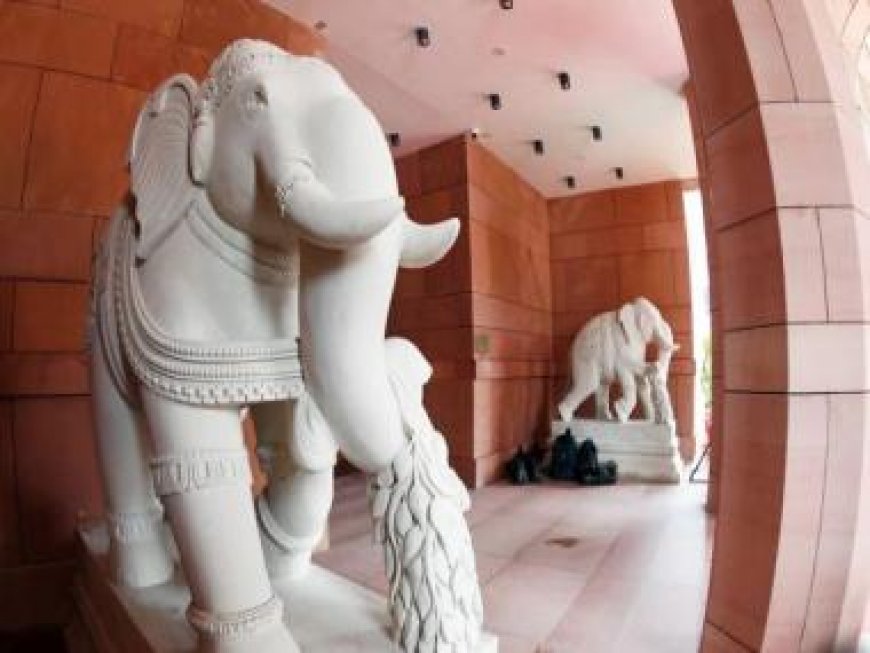Gaja, Garuda, Ashva… What the six entrances to the new Parliament symbolise
Gaja, Garuda, Ashva… What the six entrances to the new Parliament symbolise

As India celebrates Ganesh Chaturthi by welcoming Lord Ganesha, the country’s parliamentarians will be busy at work. But they have something new to look forward to. Come Tuesday, proceedings will shift to the new Parliament building, which was inaugurated by Prime Minister Narendra Modi on 28 May.
The special session, which kicked off on Monday, will move to the brand-new Sansad. A Ganesh puja will be reportedly held. The grand structure, which will witness many historic moments in the years to come, has intriguing features. For starters, it has six entrances – Gaja Dwar, Ashwa Dwar, Garuda Dwar, Makar Dwar, Shardula Dwar and Hamsa Dwar. Each one of these doors has a sculptor of a guardian animal – some of them mythological creatures – and they represent different aspects of Indian history and culture. They have been placed as doorkeepers.
We take a look at the significance of these grand gates of the new Parliament.
Also read: New Parliament of India: What’s different from the old one?
Gaja Dwar
On Sunday, Vice-President Jagdeep Dhankhar hoisted the national flag at the Gaja Dwar, the entrance to the north of the new Parliament. A Gaja (an elephant) has been installed at the door, as it represents wisdom and wealth, intellect, and memory, and also embodies the aspirations of the elected representatives of the democracy, according to a government note.
According to Vaastu Shastra, the north is associated with Planet Mercury, which is believed to be a source of intellect. Elephants, which are a common motif in Indian architecture, are said to bring prosperity and happiness.
Two white tuskers with intricate work stand guard at the entrance to the north of the new building.

Ashva Dwar
The Ashva Dwar is guarded by horse sculptures. This is the southern entrance of the new Parliament.
Ashva is the Sanskrit word for horse. The animal finds a mention in the Vedas and other Hindu scriptures and books like Ramayana. A horse is a symbol of power, strength, endurance, courage and speed, qualities which hold value when it comes to governance.
Also read: Who is Bimal Patel, the man who designed the new Parliament building?
Garuda Dwar
The Garuda Dwar is the eastern entrance of the building and gets its name from the eagle-like bird which stands at the door.
According to Hindu mythology, the garuda is a divine creature, a humanoid bird, and a vahana (mount) of Lord Vishnu. The animal is mentioned in several ancient texts like the Puranas, Vedas, and Mahabharata. It is said to be the king of birds.
The Garuda is a symbol of dharma (duty) and power, according to a report in NDTV. It is also used in insignia of several countries.
The bird at the eastern entrance of the Parliament signifies the aspirations of the people of India. The east is associated with the rising sun; it represents hope, victory, and success, according to Vastu Shastra, say government officials.

Makara Dwar
The Makara Dwar faces the entrance of the old Parliament building. It is named after the mythological sea creature, makara, which combines the bodily parts of different animals.
In Hindu mythology, makara is the vahana of the Ganga and Narmada, the river goddesses, and Varuna, the god of the ocean. They are considered guardians of gateways and their sculptures are often found outside throne rooms in palaces and entryways to temples.
Makaras are a common feature in Hindu and Buddhist temples across Asia. They are seen as gargoyles or spouts attached to a water spring.
Makara sculptures at the Parliament represent unity in diversity among the people of the country as the creature is a combination of different animals.

Shardula Dwar
The fifth gate of the new Parliament building is called the Shardula Dwar. It is named after another mythological creature, which has the body of a lion but the head of a horse, elephant or parrot.
Shardula is said to be the most powerful of all living beings. The presence of Shardula on the new parliament building’s gate symbolises the power of the people of the country, says the government note.
Hamsa Dwar
The sixth entrance of the Parliament is called the Hamsa Dwar. It gets its name from the swan, hamsa in Sanskrit, which flanks the public entrance to the northeast of the building.
Hamsa is the mount of Goddess Saraswati, the deity of knowledge. In a democracy, the power of discernment and self-realisation born out of wisdom are important qualities its people should possess. The hamsa at the entrance is a reminder of this.
Of the six entrances, three are ceremonial entrances, which will be used to welcome special guests and mark special events.
With inputs from agencies
What's Your Reaction?

























































